

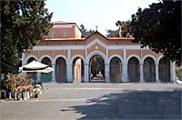
Bishop Gioacchino Pecci (the future Pope Leo XIII) inaugurated this cemetery in 1849. It soon proved to be too small, and Alessandro Arienti supervised its extension in the period 1874-86. Its elegant portal (illustrated above) and the two galleries along the longer sides of the cemetery belong to this latter period.
The hypogeum (2nd-1st centuries BC) of the Rafi family was discovered cut into the rock here in 1887. It contained 36 cinerary urns, many of which are now displayed in the Museo Archeologico.
Walk along the main path through the cemetery to the Monument to the Fallen (below). If you turn right here, you will see the side of the church of Santa Maria delle Grazie in front of you, and you can reach it via a pedestrian bridge over the Via Enrico dal Pozzo. This now acts as the church of the cemetery.
Begin your walk along the path along the middle of the cemetery, which leads to the Monument to the Fallen (below).
Tomb of Mario Grecchi (ca. 1945)
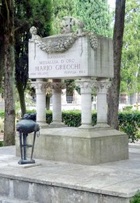
Cappella della Confraternita della Misericordia (1888)
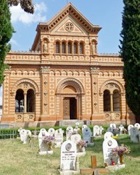
Monument to the Fallen (1864-75)
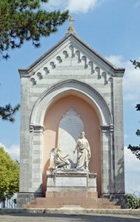
The grave here also contains the remains of Domenico Lupattelli, a Perugian patriot, who was captured and executed in 1844 while fighting against the Bourbon monarchy in Calabria. His remains were returned to Perugia in 1868. Piazza Lupatelli (see Walk V) is named for him.
Biscarini Monument (1874)
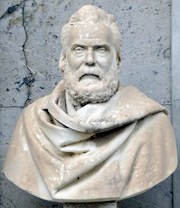
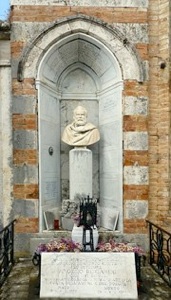
Bust (1874) of Angelo Biscarini Senior Biscarini Monument
The monument to Angelo Biscarini senior, the father of Francesco Biscarini, was erected at the far left-hand corner of the cemetery on his death in 1874. He is commemorated on the column that supports his bust.
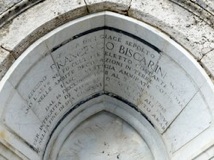
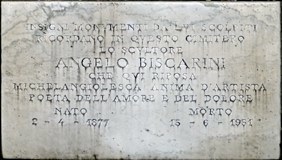
Inscription (1903) to Francesco Biscarini Inscription (1951) to Angelo Biscarini
Other inscriptions commemorate:
-
✴Francesco Biscarini (above); and
-
✴his nephew, Angelo Biscarini (below).
Percorso Angeletti e Biscarini

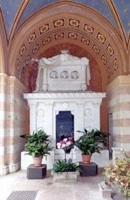
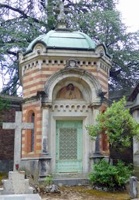
Tomba Fioretti (1868) Tomba Angelini-Paroli (1883) Cappella Fani (1892)
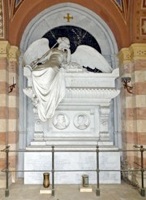
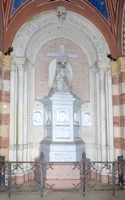
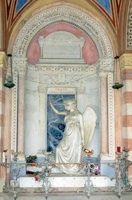
Tomba Nottari (1888) Tomba Rizzoli-Ticchioni (1893) Tomba Paolo Angeloni (1897)
The monuments in cemetery commissioned from the studio of Raffaelle Angeletti and Francesco Biscarini in the late 19th century are described in a guide to the cemetery referenced below (pp 71-5). They included the six illustrated above, which can be located using the plan on p. 72 of the guide.
Percorso Angelo Biscarini
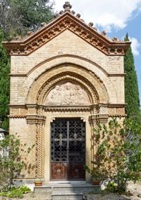

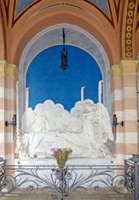
Cappella Doneddu (1907) Cappella Radicioni (1909) Tomba Mammalucchi (1912)
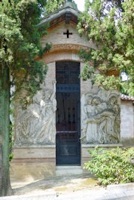
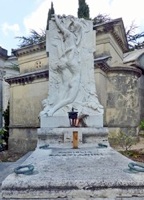
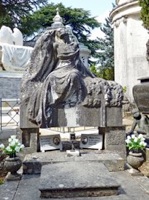
Cappella Buon-Tromboni (1926) Tomba Bastianini (1927) Tomba Misuri-Benda (1938)
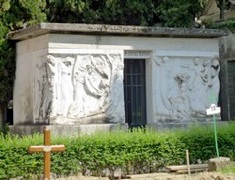
Tomba Teatini (1935-8)
The monuments in cemetery commissioned from Angelo Biscarini in the early 20th century are also described in a guide to the cemetery referenced below (pp 76-9. They included the seven illustrated above, which can be located using the plan on p. 76 of the guide.
Read more:
R. Zuccherini, “Il Cimitero Monumentale di Perugia”, (2012 ) Perugia
Return to Monuments of Perugia.
Return to Walk VI.

